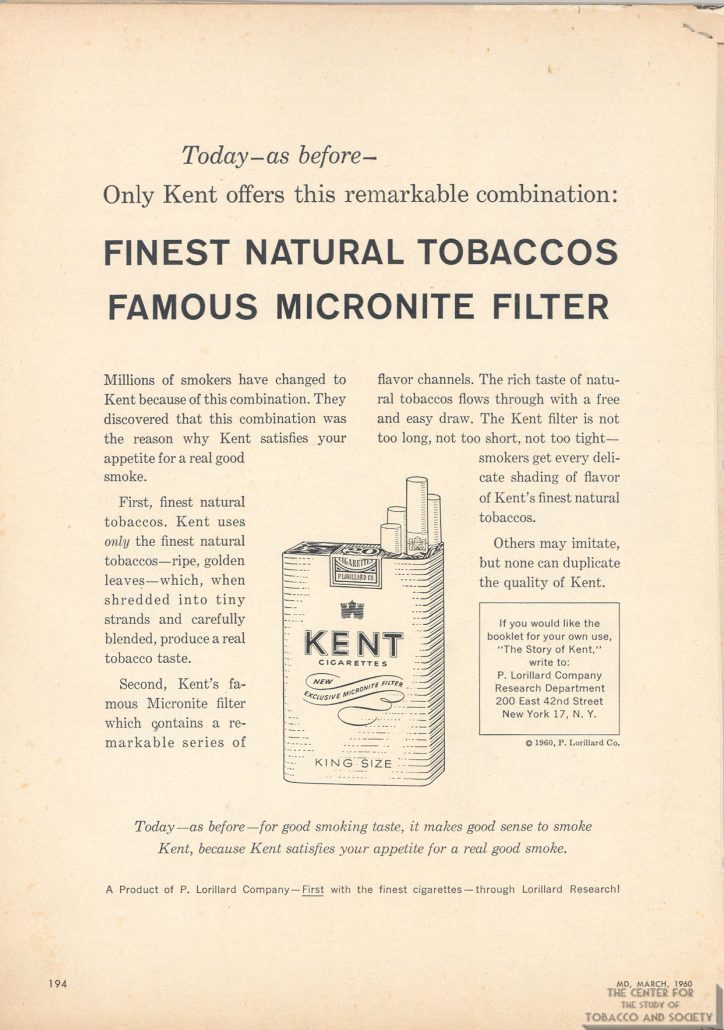(Click the above link to view an in depth history of the cigarette filter)
-
The Filter Fraud
-
Although attaching a filtering device to the end of the cigarette that is held in the lips may have originated in the late-19th century with the use of cotton wool or “a piece of net or webbing secured over one end of the cigarette” (according to an item, “New Things: Web-Tipped Cigarettes,” in the January 5, 1885 issue of the British trade journal TOBACCO), the main purpose was to prevent “fibres of tobacco and dust being drawn into the mouth.” A filter made of crepe paper was invented in 1925. Cork-tipped cigarettes became fashionable in the 1930s, and the paper around many cigarette filters today is printed to resemble cork.
-
-
-
In the 1950s, confronted with declining cigarette sales after the publication of research reports linking smoking to lung cancer, tobacco companies began producing filter-tipped brands that were claimed to remove certain components of the smoke…which manufacturers never acknowledged to be harmful!
-
-
-
In 1952 the P. Lorillard Tobacco Company promoted the Micronite filter on its Kent cigarettes, made of a material “so safe, so pure, it’s used to filter the air in many hospitals.” This material was blue asbestos, also known as crocidolite, the Inhalation of which can cause lung cancer, mesothelioma (cancer of the lining of the lung), and debilitating chronic lung disease. By 1957, Lorillard had quietly changed the material in the Micronite filter to cellulose acetate fibers, a bioplastic material created in 1865 and long used in the manufacture of playing cards and photographic film. In 1963 Liggett & Myers introduced Lark cigarettes with a charcoal filter. [To read, hear, and see more about the Micronite filter, use this link.]
-
-
-
Today most cigarette filters are made of cellulose acetate fiber, which is non-biodegradable. An estimated 5.6 trillion cigarettes are smoked every year worldwide, of which 4.5 trillion cigarette butts become litter. The cellulose acetate filter is the single most common waste item picked up over the last 30 years on beaches and urban cleanups.
-
-
-
No filter confers any health benefit or reduces harm. In fact, because the filter causes the smoker to inhale more deeply and more frequently to obtain the needed nicotine and the flavor, thus increasing exposure to poison gases like carbon monoxide, cyanide, and ammonia, filtered cigarettes increase the risk of emphysema, lung cancer, and heart disease. Today 99% of cigarettes sold in the US are filtered brands. The tobacco industry has succeeded in convincing the smoking public that a filter makes cigarettes safer.
-
“A Safer Cigarette”
Ed Stein
The Rocky Mountain News (Denver, Colorado)
1996
“I grew up in the blacklands of Central Texas, where if you weren’t a wimp or a dweeb you knew how to Bogart that cigarette. I knew all the tricks. I could light a match with my teeth, my thumbnail, or my zipper. I could French inhale, I could hold a whole cigarette lit-end first inside my mouth, I could fling a butt 30 yards with one disdainful flick of the finger. I was cool. I was a dope. A decade or so later, I got so mad at myself for what smoking was doing to me I quit cold. Carried a pack around in my pocket for days, but every time I reached for it, the wave of revulsion that washed over me stopped me from lighting up. After three weeks I threw the pack away, and that was that. My only revenge is to hammer away at the evil varmints who put all that Marlboro Country nonsense in my dumb teenage brain in the first place.”
— Ed Stein
“Cigarette Industry Pins Hopes on Better Filters”
News article
Tobacco: The International Weekly
January 24, 1964
“Cigarettes recalled due to defective filters…”
Steven Lait
The Oakland Tribune (Oakland, California)
1995
“SMOKE SAFELY WITH Congress Filter…”
Ed Stein
The Rocky Mountain News
1984
“Headline: ‘Poison gas’ in some filter cigarettes”
Wayne Stayskal (1931-2018)
The Chicago Tribune
1976







![Viceroy's Got the Deep-Weave Filter [Ad] Viceroy Brown and Williamson Tobacco Corporation 1964 (2)](https://csts.ua.edu/files/2020/12/Viceroys-Got-the-Deep-Weave-Filter-Ad-Viceroy-Brown-and-Williamson-Tobacco-Corporation-1964-2-767x1030.jpg)




